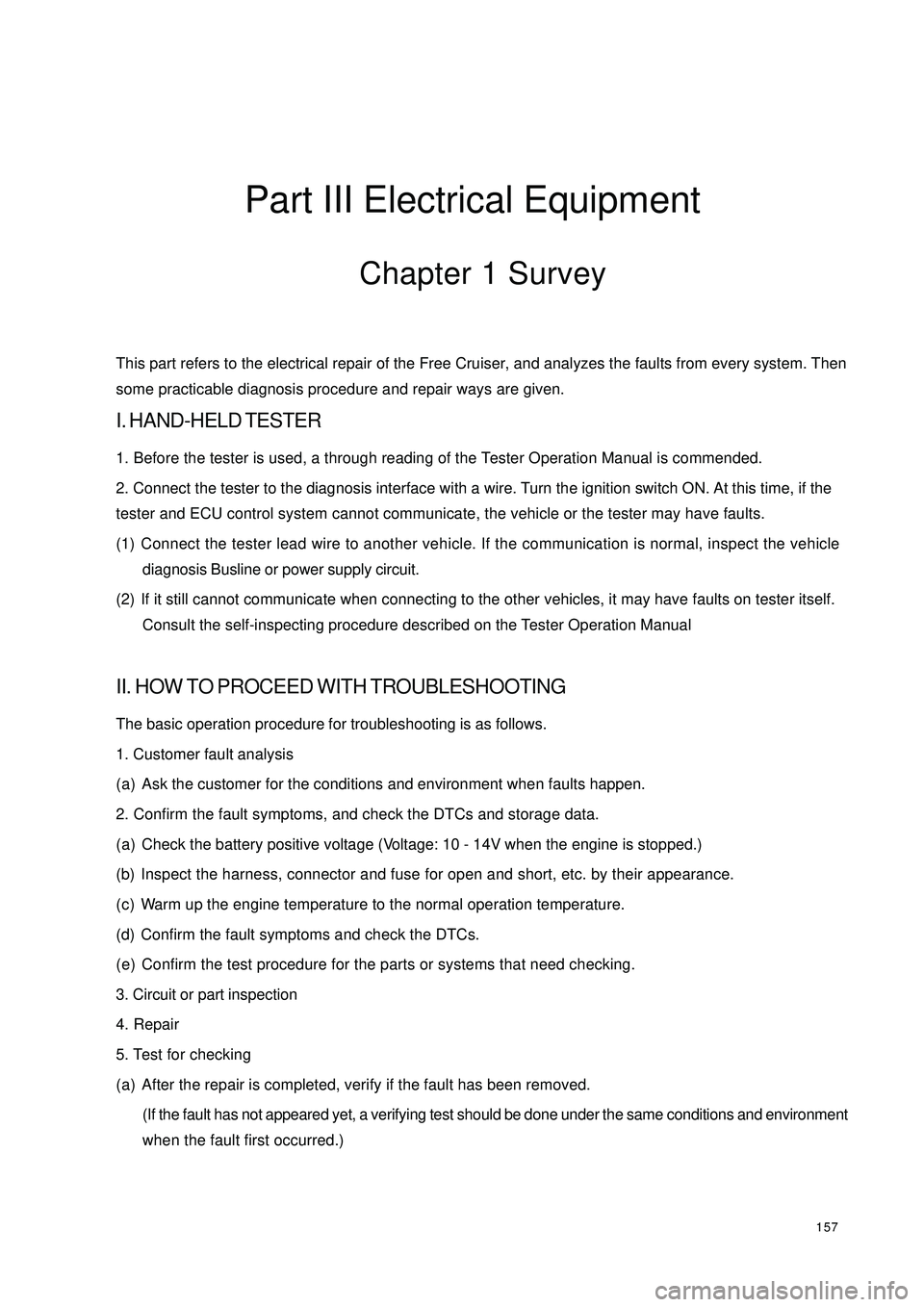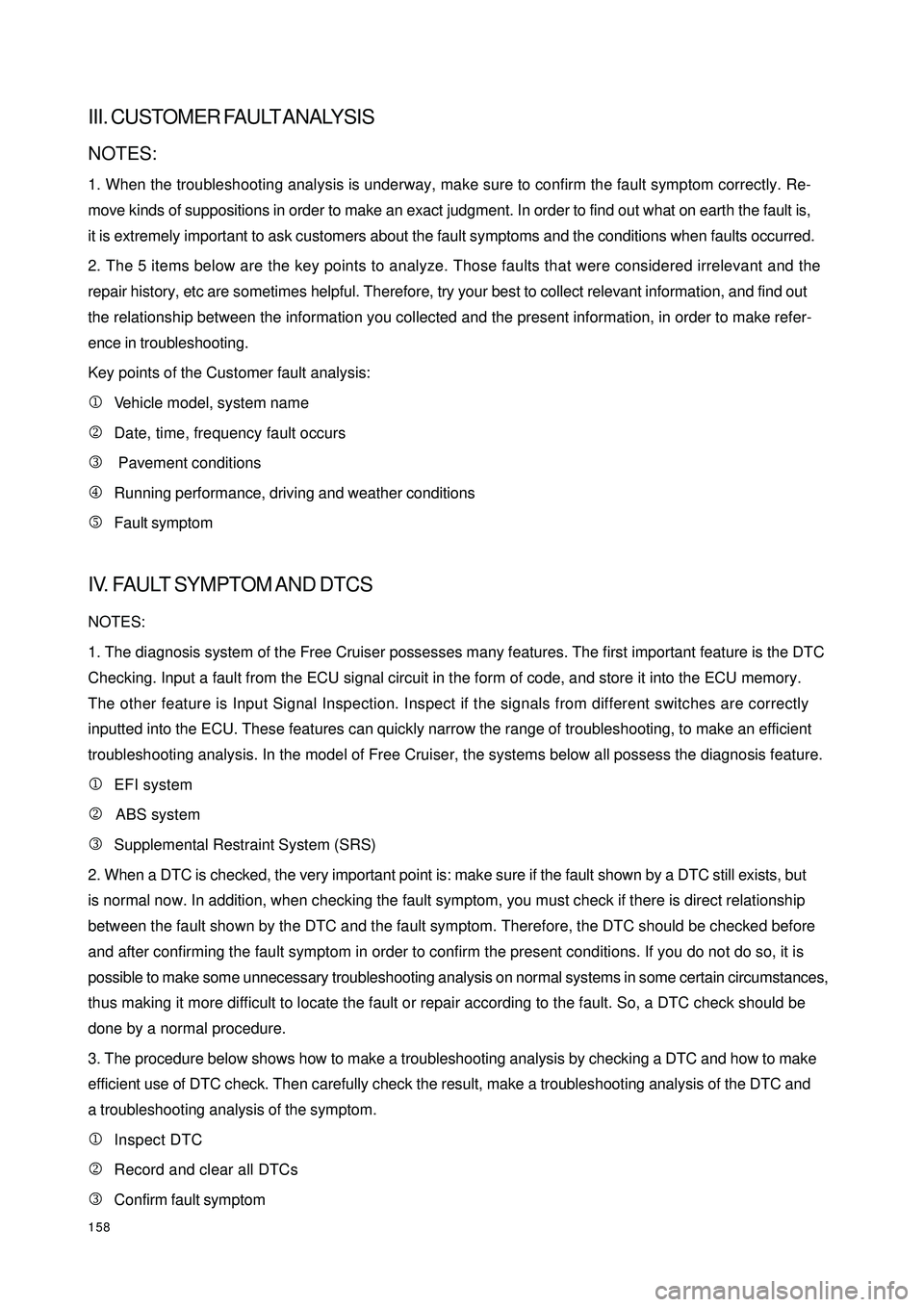Page 164 of 392

157Part III Electrical EquipmentChapter 1 SurveyThis part refers to the electrical repair of the Free Cruiser, and analyzes the faults from every system. Then
some practicable diagnosis procedure and repair ways are given.I. HAND-HELD TESTER1. Before the tester is used, a through reading of the Tester Operation Manual is commended.
2. Connect the tester to the diagnosis interface with a wire. Turn the ignition switch ON. At this time, if the
tester and ECU control system cannot communicate, the vehicle or the tester may have faults.
(1) Connect the tester lead wire to another vehicle. If the communication is normal, inspect the vehicle
diagnosis Busline or power supply circuit.
(2) If it still cannot communicate when connecting to the other vehicles, it may have faults on tester itself.
Consult the self-inspecting procedure described on the Tester Operation ManualII. HOW TO PROCEED WITH TROUBLESHOOTINGThe basic operation procedure for troubleshooting is as follows.
1. Customer fault analysis
(a) Ask the customer for the conditions and environment when faults happen.
2. Confirm the fault symptoms, and check the DTCs and storage data.
(a) Check the battery positive voltage (Voltage: 10 - 14V when the engine is stopped.)
(b) Inspect the harness, connector and fuse for open and short, etc. by their appearance.
(c) Warm up the engine temperature to the normal operation temperature.
(d) Confirm the fault symptoms and check the DTCs.
(e) Confirm the test procedure for the parts or systems that need checking.
3. Circuit or part inspection
4. Repair
5. Test for checking
(a) After the repair is completed, verify if the fault has been removed.
(If the fault has not appeared yet, a verifying test should be done under the same conditions and environment
when the fault first occurred.)
Page 165 of 392

158III. CUSTOMER FAULT ANALYSISNOTES:
1. When the troubleshooting analysis is underway, make sure to confirm the fault symptom correctly. Re-
move kinds of suppositions in order to make an exact judgment. In order to find out what on earth the fault is,
it is extremely important to ask customers about the fault symptoms and the conditions when faults occurred.
2. The 5 items below are the key points to analyze. Those faults that were considered irrelevant and the
repair history, etc are sometimes helpful. Therefore, try your best to collect relevant information, and find out
the relationship between the information you collected and the present information, in order to make refer-
ence in troubleshooting.
Key points of the Customer fault analysis:
1Vehicle model, system name
2Date, time, frequency fault occurs
3 Pavement conditions
4Running performance, driving and weather conditions
5Fault symptomIV. FAULT SYMPTOM AND DTCSNOTES:
1. The diagnosis system of the Free Cruiser possesses many features. The first important feature is the DTC
Checking. Input a fault from the ECU signal circuit in the form of code, and store it into the ECU memory.
The other feature is Input Signal Inspection. Inspect if the signals from different switches are correctly
inputted into the ECU. These features can quickly narrow the range of troubleshooting, to make an efficient
troubleshooting analysis. In the model of Free Cruiser, the systems below all possess the diagnosis feature.
1EFI system
2 ABS system
3Supplemental Restraint System (SRS)
2. When a DTC is checked, the very important point is: make sure if the fault shown by a DTC still exists, but
is normal now. In addition, when checking the fault symptom, you must check if there is direct relationship
between the fault shown by the DTC and the fault symptom. Therefore, the DTC should be checked before
and after confirming the fault symptom in order to confirm the present conditions. If you do not do so, it is
possible to make some unnecessary troubleshooting analysis on normal systems in some certain circumstances,
thus making it more difficult to locate the fault or repair according to the fault. So, a DTC check should be
done by a normal procedure.
3. The procedure below shows how to make a troubleshooting analysis by checking a DTC and how to make
efficient use of DTC check. Then carefully check the result, make a troubleshooting analysis of the DTC and
a troubleshooting analysis of the symptom.
1Inspect DTC
2Record and clear all DTCs
3Confirm fault symptom
Page 166 of 392

1594Make a simulation test in a way of symptom simulation
5Inspect DTC
6Confirm symptomV. SYMPTOM SIMULATIONNOTES:
The most difficult conditions to handle in the fault troubleshooting are that the fault symptom dose not appear.
Under the circumstances, make sure first to make a comprehensive analysis to the fault described by the
customer, then to simulate an environment that is similar or the same with the conditions when the fault of the
customer's vehicle occurred. No matter how rich the experience of the technician is and how skillful he is, if
he make a fault troubleshooting analysis without confirm the fault symptom, it is inevitable for him to neglect
some important factors and incorrectly guess, which may cause barriers to repair. For example, if a fault
occurs only when the engine is cool or if a fault occurs only caused by a vibration from pavement and so on,
when the engine is checked in the hot or static state, it is no way to confirm. Because of vibration, high-
temperature or seeping water (Vapor) often causes some faults that are difficult to reappear. So, here are
some effective symptom simulation tests.
KEY POINTS OF SYMPTOM SIMULATION TEST:
In the symptom simulation test, no doubt it is important to confirm the fault symptom, but the fault position or
fault components must be also found out. So, before the test and the pre-inspection of connection, narrow the
range of the circuit where faults may occur according to the fault symptom. Then make a symptom simula-
tion test to see if the circuit measured is normal; the fault symptom is also verified at the same time.
1. Way of Vibration: When vibration may be the major cause of the fault.
For example:
(a) Use your hand to gently vibrate the sensor that is considered the cause of the fault, in order to check if it
is ineffective.
(b) Softly rock the connector and harness in horizontal and vertical direction.
Notes: Hard rock may cause the relay circuit open.
2. Way of Spraying Water: When rainy weather or wet environment may be the major cause of the fault.
(a) Spray water on the vehicle to check if the fault occurs.
NOTES:
�yBe sure not to directly spray water into the engine compartment. Spray the water on the face of the
radiator to change the temperature and humidity indirectly.
�yBe sure not to spray water onto electronic devices and controllers.
Page 183 of 392
176(b) Inspect the combination meter connectors.
1 Inspect continuity
�yDisconnect the connector from the combination meter assembly
�y Inspect continuity between terminals
Standard:
2Inspect voltage
�yDisconnect the connector from the combination meter assembly
�yTurn the ignition switch ON
�yInspect voltage between terminals
Standard:
Result and solution:
NormalReplace the combination meter assembly
AbnormalRepair or replace the harness or connectorTe ste r c onne c tion Condition Sta ndard c ondition
B4 - ground Turn the ignition switc h ON 10 – 14VTe ste r c onne c tion Condition Sta nda rd c ondition
B7 - ground Norma l condition Continuity
B8 - ground Norma l condition Continuity
Page 186 of 392
179�yInspect voltage between terminals
Standard:
Result and solution:
AbnormalRepair or replace the harness or connector
NormalInspect the speed sensor output signal
3Inspect the speed sensor output signal
Inspect voltage
�yHold the front wheels up
�yPush the shift lever to NEUTRAL
�yTurn the ignition switch to ON
�ySlowly turn the front wheel, measure the voltage between terminal 1 and 2
Standard voltage is as follows:
Voltage changes alternately
Result and solution:
NormalRepair or replace the harness or connector
Abnormalreplace the speed sensorTurning WheelsBelow 0.5VTe ste r c onne c tion Condition Sta nda rd c ondition
3 - ground Turn the ignition switch to ON 7.5 – 9V
Page 187 of 392
180(c) Inspect the combination meter assembly
1Remove the combination meter assembly and disconnect connectors.
2 Inspect continuity
�yInspect continuity between terminals
Standard:
3Inspect voltage between terminals
Result and solution:
AbnormalRepair or replace the harness or connector
NormalReplace the combination meter assemblyTeste r c onne ction Condition Sta ndard c ondition
B7 - ground Normal c ondition Continuity
B8 - ground Normal c ondition ContinuityTe ste r c onne c tion Condition Sta nda rd c ondition
B4 - ground Turn the ignition switch to ON 10 – 14V
Page 191 of 392
184Standard:
Result and solution:
NormalReplace the combination meter assembly
If abnormalinspect the water temperature sensor
2Inspect the water temperature sensor
�yRemove the water temperature sensor and put it into the constant temperature cabinet.
�yAdjust the temperature in the constant temperature cabinet and measure the resistance of the
water temperature sensor.
Standard:
Result and solution:
NormalRepair or replace the harness and connector
If abnormalreplace the water temperature sensorTe ste r c onne c tion Condition Standa rd condition
C(60℃
)164.5±5Ω
1/2C(90℃
) 56±3Ω
H(115℃
)28.7±2Ω B5 - groundC ondit ion S t a nda r d c ondit ion
C(60℃
) 164.5±5Ω
1/2C(90℃
)56±3Ω
H(115℃
) 28.7±2Ω
Page 193 of 392
186Standard:
Result and solution:
Normal:Repair or replace the harness and connector
If abnormal replace the fuel level sensor
6. THE OTHER INDICATORS
Short the ports of the other indicators respectively to the ground or power source in accordance with the
Circuit Diagram, the indicators will light correspondingly. If it dose not light, replace the combination meter.
If it lights, repair or replace the harness or connector.
7. ODOMETER MALFUNCTION
Inspect first supposing the problem to be from the speedometer. If the speedometer is normal, the combina-
tion meter needs replacing when the odometer is abnormal.Condition Standa rd condition
E 110±6Ω
1/2 32.5±3Ω
F3±2Ω